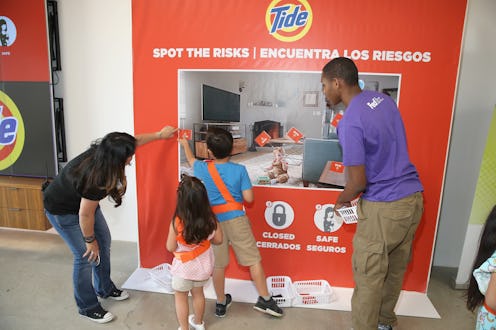News
Detergent Pods Are More Dangerous Than You Realize
Laundry detergent pods are great: They're tidy, efficient and attractive. They're also insanely dangerous to kids, according to an unprecedented study on the seemingly innocuous household item. Published Monday in the journal Pediatrics, the study found detergent pods posed a significant health risk to children, particularly to babies and toddlers. Researchers confirmed what some of us have thought all along — those brightly colored detergent pods look exactly like hard candy and have been tricking kids at an alarming rate.
The researchers used data from the National Poison Data System to analyze how many children under the age of six have been exposed to laundry detergent pods between 2012 and 2013 — the first two years in which laundry detergent pods were introduced to the American public. The NPDS is ran by the American Association of Poison Control Centers, which tracks poison emergency calls made to call centers across the country.
What the researchers found was astonishing — though not unsurprising. According to the study, in just one year more than 17,200 children under the age of six were exposed to detergent pods, including inhaling, squirting or swallowing the contents.
Nearly 74 percent of the cases affected children under the age of three, with one-year-old children making up the bulk of the poison cases. Almost 80 percent of the incidents involved ingesting the liquid detergent.
Although just 4.4 percent of the cases resulted in hospitalization, the researchers concluded:
The colorful, candylike designs of the products [detergent pods] may have contributed to a recent phenomenon involving young children gaining access to the detergent pods and ingesting them or bursting them open, exposing their skin or eyes to the detergent chemicals. Exposure has resulted in hospitalization and mechanical ventilation for several days. Serious medical consequences have been documented, including respiratory distress, marked lethargy and depression of consciousness, and damage to oropharyngeal mucosa.
The researchers calculated the rate of exposure as 3.67 per 10,000 U.S. children under the age of six — or nearly one child per hour. Almost 100 percent of the cases occurred at a residence, and more than 40 percent involved pods that were left out in the open, leading us to believe these bite-sized detergent packets pose a major household risk.
As for how the pods cause so much damage to children under the age of three, the researchers explained:
These ages represent a developmental period of newfound mobility, exploration, curiosity, and teething. It is a time when children commonly place items in their mouths. One study that examined data from the Texas Poison Center Network found this same age pattern for laundry detergent pod exposures. Our finding that ingestion is the most common route of exposure corroborates the results of other studies.
Medical researchers have been skeptical about laundry detergent pods in the past, and the Centers for Disease Control and Prevention even warned consumers in the fall of 2012 that the household item could cause health complications for children under five. The CDC said it began tracking emergency poison calls associated with detergent pods in May 2012. The CDC concluded that year that "exposure to laundry detergent from pods might be associated with adverse health effects more often than exposure to non-pod laundry detergents."
Kristin Wenger, education coordinator for the University of Virginia's Blue Ridge Poison Center, also noted on the university's website that these pods are more harmful to young children. "There’s something about these concentrated packets that’s different. … Kids are getting much sicker," Wenger said.
No one knows why these pods are more toxic, nor which toxins are the most responsible for sending kids to the emergency room. However, medical experts say it may have something to do with the consistency of the packets. "They [detergent pods] are made with almost like a very thin Saran wrap that dissolves when wet," Dr. Cynthia Aaron, medical director of the Regional Poison Control Center at Children’s Hospital of Michigan, told the The New York Times.
The researchers for the Pediatrics study agree that the medical community now needs to focus on the toxicity of the detergent pods. Until then, parents with small children should consider hiding their pod packets in hard-to-reach places — or switch back to liquid detergent.
Images: Blue Ridge Poison Center
